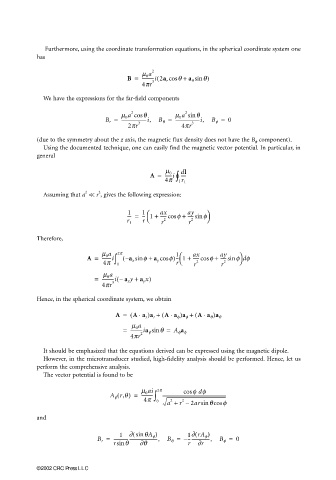Page 649 - The Mechatronics Handbook
P. 649
0066_Frame_C20.fm Page 119 Wednesday, January 9, 2002 1:47 PM
Furthermore, using the coordinate transformation equations, in the spherical coordinate system one
has
2
B = m 0 a q + a q sin q)
-----------i 2a r cos(
4pr 3
We have the expressions for the far-field components
2 q 2 q
B r = m 0 a cos B q = m 0 a sin B f = 0
----------------------i,
----------------------i,
2pr 3 4pr 3
(due to the symmetry about the z axis, the magnetic flux density does not have the B φ component).
Using the documented technique, one can easily find the magnetic vector potential. In particular, in
general
∫
A = 4p ° l dl
m 0
------i -----
r 1
2
2
Assuming that a << r , gives the following expression:
1
---- = 1 ax f + ay f
-- 1 +
-----sin
-----cos
r 1 r r 2 r 2
Therefore,
1
A = m 0 a ∫ 2p – ( a x sin f + a y cos f)-- 1 + ax f + ay f d f
--------i
-----cos
-----sin
4p 0 r r 2 r 2
m 0 a
= -----------i –( a x y + a y x)
4pr 3
Hence, in the spherical coordinate system, we obtain
⋅
⋅
A = ( A a r )a r + ( Aa f )a f + ( Aa q )a q
⋅
m 0 a
= -----------ia f sin q = A f a f
4pr 2
It should be emphasized that the equations derived can be expressed using the magnetic dipole.
However, in the microtransducer studied, high-fidelity analysis should be performed. Hence, let us
perform the comprehensive analysis.
The vector potential is found to be
m 0 ai 2p cos f df
(
A f r,q) = ---------- ∫ ---------------------------------------------------------
4p 0 a + r – 2arsin qcos f
2
2
and
(
1 ∂ sin( qA f ) 1∂ rA f )
B r = --------------------------------------, B q = – ------------------, B f = 0
rsin q ∂q r ∂r
©2002 CRC Press LLC

